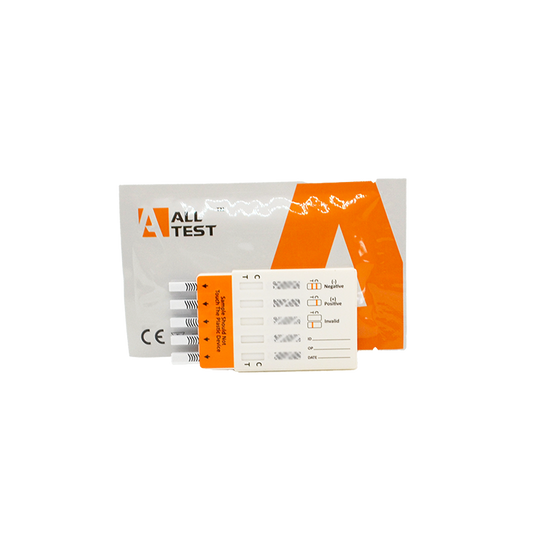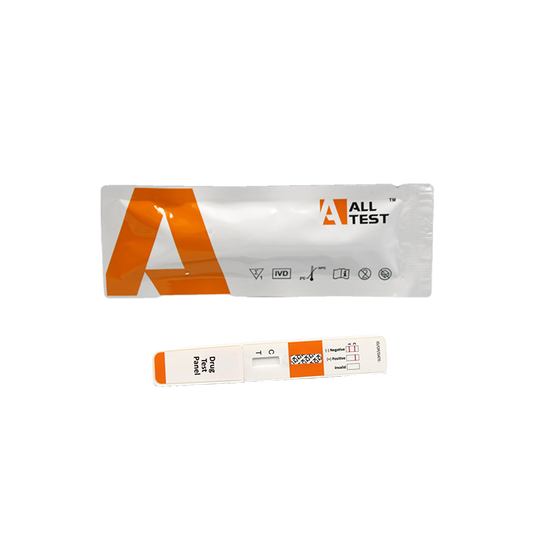If you’re considering taking MDMA (commonly known as ecstasy or molly), or simply curious about what’s really in these pills, it’s important to understand what you might be consuming. Pills sold as MDMA often contain other substances that can produce similar effects or worse, dangerous side effects.
This article explains the common ingredients found in pills, common substitutes for MDMA, how pills are made, and the truth behind myths such as “rat poison” in ecstasy. We also cover how to identify fake pills and why testing your drugs at home is crucial for safety.

Powder Drug Test Multi Panel (Workplace)
Test a powder or pill for drugs
We are currently working with our suppliers to produce a cheaper and more targeted test for pills and white powders. Subscribe to our newsletter at the bottom of the page to recieve updates on drug safety and new releases.
What Is MDMA and How Does It Appear?
MDMA (3,4-methylenedioxymethamphetamine) is a psychoactive drug known for producing feelings of euphoria, empathy, and increased energy. Pure MDMA usually appears as:
- Crystalline powder: white, beige (off-white), or light brown (Brown/Orange is often less pure and indicates a more crude creation process)
- Pressed tablets: often coloured and stamped with logos or symbols such as Soundcloud, Superman (Pill presses are often resold so there is no guarantee you are buying the same drug as someone else with the same shape).
The effects are distinct, but appearance alone doesn’t guarantee purity or safety.
Common Substitutes and Additives in Pills
Pills sold as MDMA can contain other substances, sometimes intentionally mixed to mimic MDMA’s effects or increase profit margins.
- MDA: Chemically similar to MDMA but with stronger psychedelic effects and longer duration.
- Methylone and Other Synthetic Cathinones: These “bath salts” are stimulants with effects somewhat like MDMA but can be more unpredictable and riskier.
- PMA and PMMA: Dangerous substances with slow onset and high risk of overdose and toxicity.
- Caffeine and Other Stimulants: Often added to increase perceived energy but can increase side effects like anxiety and heart strain.
- Methamphetamine - Easier to manufacture compared to MDMA so is cheaper and more widely available so is often mixed with MDMA.
Is Rat Poison Found in Pills?
A common concern is whether rat poison or similar poisons are present in pills. This is largely a myth. Verified testing by harm reduction groups and drug checking services shows:
- No evidence of common rodenticides in recreational pills.
- The real risks come from unregulated and unknown psychoactive substances like PMA/PMMA or high doses of stimulants.
How Are Pills Made?
MDMA or substitute substances are mixed with binders, fillers, and colouring agents, then pressed into tablets using molds that imprint logos or designs. There is no quality control, so pills can vary significantly in:
- Dosage strength
- Chemical composition
- Purity and safety
Appearance alone cannot confirm the contents.
Pills Often Mistaken for MDMA
Sometimes, pills sold as MDMA actually contain prescription medications or “downers” that produce very different effects. These can be dangerous if you’re expecting the typical MDMA experience. Common examples include:
- Benzodiazepines (e.g., Valium, Xanax): These are sedatives used to reduce anxiety or induce sleep. Instead of the energetic, euphoric effects of MDMA, these cause relaxation and drowsiness — often the opposite feeling.
- Opioid painkillers (e.g., tramadol, oxycodone): These act as powerful pain relievers and depressants on the nervous system. They can cause sedation and carry a high risk of overdose, especially when mixed unknowingly with other drugs.
- Antidepressants or antipsychotics: Occasionally, pills may contain these, which can blunt or completely alter the expected effects of MDMA, sometimes causing unpleasant or dangerous reactions.
- 2C-B: A psychedelic with hallucinogenic effects and similar release of MDMA’s empathogenic effects.
The Real Dangers of Taking Pills
While many people take MDMA or similar pills expecting a safe, enjoyable experience, the reality is that pills carry significant risks. Overdosing is a serious concern, especially because pills vary widely in strength and purity. Taking too much can lead to dangerous increases in heart rate, body temperature, and blood pressure sometimes resulting in seizures, organ failure, or even death.
Dehydration and overheating are also major risks at festivals and raves, where dancing for hours in hot environments is common. MDMA and similar stimulants affect your body’s ability to regulate temperature and hydration, so it’s vital to drink water regularly but not too much, as overhydration can also be harmful.
Additionally, some people have genetic differences or health conditions that affect how their bodies metabolize these drugs, making them more vulnerable to adverse reactions or overdose even at lower doses. If you have any medical concerns, it’s crucial to be especially cautious and avoid taking unknown pills altogether.
What Happens During an Ecstasy (MDMA) Overdose? Why Emergency Help Can Be Limited
In the event of an overdose on MDMA or other substances found in pills, it’s important to understand that emergency medical responders often face significant challenges. Unlike overdoses from opioids, where specific antidotes like naloxone can quickly reverse the effects, there is no direct antidote for MDMA or stimulant overdoses. Treatment mainly focuses on managing symptoms such as controlling seizures, reducing dangerously high body temperature, and supporting heart and lung function while the body processes the drug. This means paramedics and hospital staff provide critical supportive care, but there’s often little they can do to instantly reverse the overdose itself. This underscores how vital prevention, moderation, and early recognition of overdose symptoms are to reduce risk and save lives.
Causes of Death
1. Severe Hyperthermia (Overheating)
This is the most common and deadly complication. MDMA disrupts the body’s ability to regulate temperature, especially in hot environments like clubs or festivals. Combined with intense physical activity (like dancing), this can cause body temperature to spike dangerously sometimes above 40°C (104°F).
What happens:
- Organs begin to shut down
- Muscles break down (a condition called rhabdomyolysis)
- Blood clots, kidney failure, and cardiac arrest can follow
This is often the primary cause of death in otherwise healthy people.
2. Hyponatremia (Water Intoxication)
This happens when someone drinks too much water and not enough electrolytes, often because they’re trying to stay hydrated. MDMA increases antidiuretic hormone (ADH), which means your body retains more water than usual.
Result: Sodium levels in the blood drop dangerously low, leading to swelling in the brain (cerebral edema), seizures, coma, and sometimes death.
3. Cardiovascular Complications
Though less common in young, healthy people, MDMA can increase heart rate and blood pressure to dangerous levels. People with pre-existing heart conditions or undiagnosed vulnerabilities are at higher risk of arrhythmias, stroke, or heart failure.
Conclusion
If you plan to use MDMA or ecstasy pills, understanding what may be inside is essential. Pills often contain substitutes and additives that can be harmful. Avoid myths like “rat poison” in pills, and always test your drugs with reliable kits before use. Staying informed and cautious is the best way to reduce harm.



